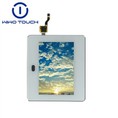As a leading touch screen supplier, I often get asked by customers, "How often should I clean my touch screen?" This is a crucial question because proper cleaning not only ensures the longevity of the touch screen but also maintains its optimal performance. In this blog, I'll delve into the factors that influence the cleaning frequency and provide some practical advice.
Factors Affecting Cleaning Frequency
Usage Environment
The environment in which the touch screen is used plays a significant role in determining how often it needs to be cleaned. If the touch screen is placed in a dusty or dirty area, such as a construction site or a manufacturing plant, it will accumulate dirt and debris much faster than one in a clean office environment. For example, in a construction site, dust particles can settle on the touch screen surface within hours, which can interfere with the touch sensitivity. In contrast, a touch screen in an air - conditioned office may only need to be cleaned once a week or even less frequently.
User Interaction
The number of users and how they interact with the touch screen also matter. A touch screen in a public place, like an information kiosk in a shopping mall, is touched by numerous people throughout the day. These users may have dirty hands, or they might transfer oils, sweat, and other substances from their fingers to the screen. As a result, public touch screens need to be cleaned multiple times a day to keep them hygienic and functional. On the other hand, a personal touch - screen device, such as a tablet used by a single individual at home, may not require such frequent cleaning.
Type of Touch Screen
Different types of touch screens have different cleaning requirements. Capacitive touch screens, which are widely used in smartphones, tablets, and many modern devices, are more sensitive to dirt and oils. The conductive properties of these screens can be affected by the presence of contaminants on the surface. For instance, a thin layer of oil from a finger can disrupt the electrical field that the capacitive touch screen relies on for touch detection. Resistive touch screens, on the other hand, are generally more robust but can still benefit from regular cleaning to maintain smooth operation.
Recommended Cleaning Frequencies
Daily Cleaning
- Public Spaces: As mentioned earlier, touch screens in public areas like airports, libraries, and museums should be cleaned daily. For example, an interactive map in a museum that is constantly being touched by visitors should be wiped down at the end of each day. This helps to remove fingerprints, smudges, and any potential germs.
- Food Service and Healthcare Settings: In restaurants, cafes, or hospitals, touch screens are often used for ordering systems or patient check - ins. These screens come into contact with food particles, body fluids, and other contaminants. Daily cleaning is essential to prevent the spread of bacteria and ensure proper functionality.
Weekly Cleaning
- Office Environments: Touch screens used in offices, such as those on all - in - one computers or presentation devices, can typically be cleaned on a weekly basis. Since the usage is relatively controlled and the environment is clean, weekly cleaning is sufficient to keep the screens looking and performing well.
- Personal Devices: For personal tablets and smartphones, a weekly cleaning routine can help maintain the screen's clarity and touch sensitivity. You can use a microfiber cloth to gently wipe the screen and remove any accumulated dirt or fingerprints.
Monthly Cleaning
- Low - Traffic Areas: If a touch screen is installed in a low - traffic area, such as a storage room or a rarely used conference room, monthly cleaning may be adequate. These screens are not exposed to a large number of users or environmental contaminants, so less frequent cleaning is required.
Cleaning Methods
When cleaning a touch screen, it's important to use the right materials and techniques. Avoid using abrasive materials, such as paper towels or rough cloths, as they can scratch the screen. Instead, use a soft microfiber cloth. You can slightly dampen the cloth with distilled water or a small amount of isopropyl alcohol (no more than 70% concentration). Gently wipe the screen in a circular motion, starting from the center and moving outwards.


Our Touch Screen Products
As a touch screen supplier, we offer a wide range of high - quality touch screens to meet different needs. For example, our 3.5 - inch 320x480 Resolution White Capacitive Touch Screen: Advanced Surface AF Coating features an advanced anti - fingerprint coating, which makes it easier to clean and maintain. The 4.3 " Capactive Touch Screen I2C Interface To An RGB is designed for seamless integration and reliable performance. And our 4.3 inch Smart Home Touch Panels are perfect for modern smart home applications.
Conclusion
In conclusion, the frequency of cleaning your touch screen depends on various factors such as the usage environment, user interaction, and the type of touch screen. By understanding these factors and following the recommended cleaning frequencies and methods, you can ensure that your touch screen remains in top condition for a long time.
If you are interested in our touch screen products or have any questions about touch screen maintenance, we encourage you to reach out to us for a procurement discussion. We are committed to providing you with the best touch screen solutions and support.
References
- Smith, J. (2020). Touch Screen Technology: Principles and Applications. Publisher XYZ.
- Johnson, A. (2019). Cleaning and Maintenance of Electronic Displays. Journal of Electronic Device Care, 15(2), 45 - 52.




